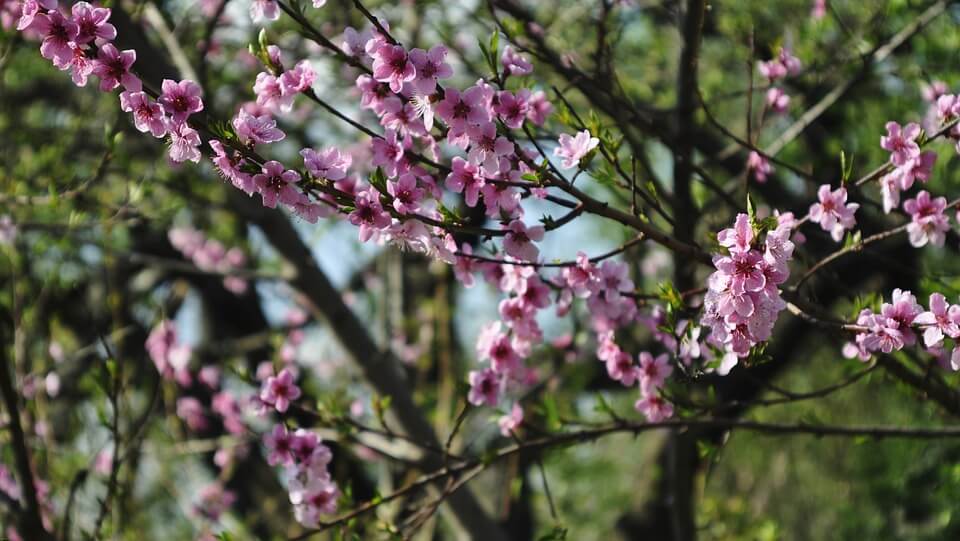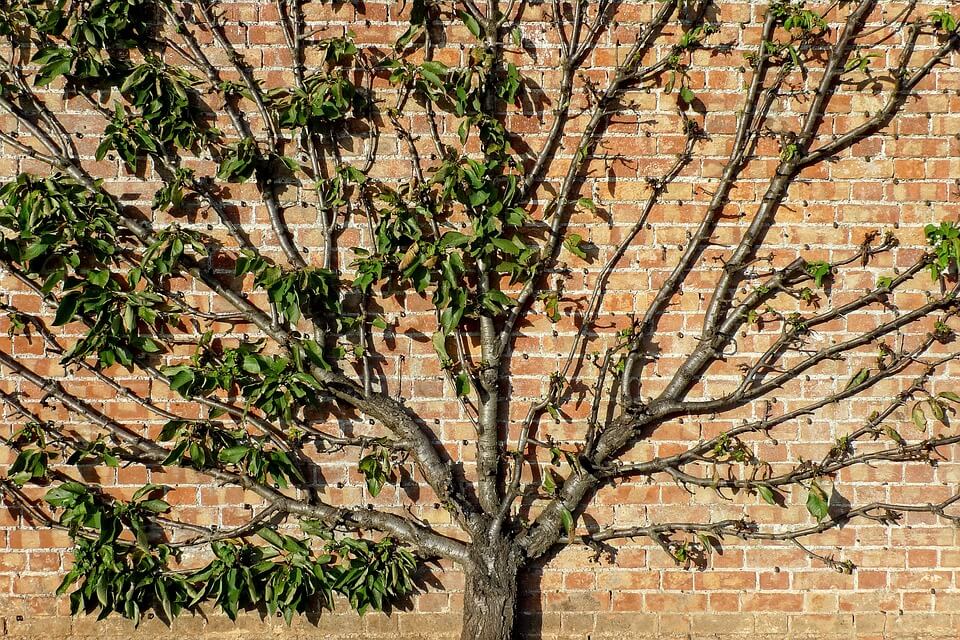With a bewildering array of options, deciding on your first tree can be a drawn out process. First there is a decision about which variety to choose. Varieties differ in their uses, taste, date of ripening, disease-resistance and fertility. Then, there is the decision about how you want your tree to be supplied. Trees can be supplied as bare root or containerised, and varieties can be grafted onto different rootstocks, which will affect a tree’s size and time to fruit.
Contents:
Uses
Cultivars can be divided into dessert, cooking and cider apples. Dessert apples are sweeter and cooking apples larger and more acidic. Dessert apples are great for eating fresh of the tree – a typical example being the Cox, which is both aromatic, crisp and juicy. Cooking differ in that they’re firm and maintain their structure when cooked, the best of which remains Bramley’s Seedling. Sour straight off the tree, cooking apples’ flavour improves in storage as the acidity falls over time. Likewise, cider apples often taste awful straight off the tree due to the high levels of astringency and bitterness. However, it is these features that add color, body and mouthfeel to a pint, producing a well proportioned flavour. Not all varieties belong exclusively to one category, for example the versatile Granny Smith is great both fresh and cooked.
Taste
Each variety has a fascinating history of its own and came into being for a variety of reasons. Some are simply found by chance, like the Christmas Pippin, found growing at the side of the M4. Others are historical varieties and have been known for hundreds of years such as Ashmead’s Kernel, originating from the 18th century. Historical cultivars are produced in abundance with the most popular dessert and cooking apple in the UK (Cox and Bramley), originating from the 19th century. Others, produced through various breeding programmes, are selected for certain characteristics. These modern varieties are often recipient of RHS Award of Garden Merit and are superior in many respects to their predecessors.
Before deciding on a dessert apple, it can be worthwhile trying what’s on offer in a supermarket, but not all varieties will be available to purchase as a tree. Cripps Pink (better known by its brand name Pink Lady) is not available to purchase in the UK due to fears from the brand owner the UK’s climate will not do the apple justice.
If you want a recommendation, look no further than Cox’s Orange Pippin – aromatic, crisp and juicy – it’s nuanced taste is far better than imported cultivars such as Braeburn and it’s descendents. A similar modern variety, Red Windsor, itself a descendent of the Cox, has the same robust flavour and aromatic qualities, although is a tad sharper. For something different, try russet and Worcester Pearmain apples. Russets are distinctive for their rough, brownish skin with a taste oft described as sweet and nutty, similar to pineapples. Worcester Pearmain, on the other hand, is distinctive for its strawberry flavour, a trait which has contributed to its popularity with breeders.
For both cooking and cider making, two varieties are often combined to produce the best depth of flavour. For apple pie for example, it is common to combine a sweet and tart apple. For cider varieties, apples vary in their acidity, tannins and sugars, producing four flavours: bittersweet, bittersharp, sharp and sweet. The most popular cooking apple and probably the best, is Bramley’s Seedling. Rare for a historical variety, this cultivar is recipient of RHS’ Award of Garden Merit, which means it’s the best of its kind.

Date of Ripening
Apples can be divided into early, mid and late picking season varieties with apples ripening from early summer to late autumn. The picking date varies significantly on location, but a mid season variety will always ripen later than an early season variety. If you are to buy more than one tree, it is recommended you buy trees with different picking seasons to ensure you have fresh apples throughout harvest period, rather than endure a glut.
Different picking season apples exhibit different storage qualities. Early varieties are best eaten straight off the tree and do not keep. They tend to be brightly coloured and are often sweet and juicy with a natural waxiness. Mid-season varieties do not keep well either, but their freshness can be extended with refrigeration. They tend to be firm fleshed and harder skinned. Late season apples can be kept for several weeks or months with some varieties’ flavour improving after a period of storage. Generally, they are very rich in flavour, drier in texture and russetted.
Disease Resistance
Apple trees suffer from a range of diseases, most of which are easily treatable through containment and fungicides. Many affect the fruit itself, noticeable by retarded growth, discoloration and abscesses. Others cause damage to the leaves, stem and roots, reducing a tree’s productivity. Common problems include canker, scab and powdery mildew and it is resistance to these diseases one should watch out for.
Varieties with good disease resistance have long been selected for breeding programmes, producing cultivars with excellent disease resistance such as Red Windsor. It is modern cultivars such as these that are best selected if you are an organic gardener unwilling to use fungicides.
Fertility

Like most fruiting species, apple trees can be self-fertile or self-sterile. Self-sterile varieties, deprived of the pollen from another cultivar, will not produce fruit. However, it is probable that you already live within range of another apple tree, especially if you are in an urban area. Crabapples will also pollinate apple trees and can be commonly found in commercial orchards. So, overall it is likely, you do not need to purchase two trees unless you live in an isolated location.
If you are in an isolated location, it is worth noting triploid trees will not pollinate other cultivars, so it is important to buy it with either: a self-fertile variety or two self-sterile varieties. It is also worth noting that all apples trees, including self-fertile varieties, benefit from a pollination partner, so for bigger crops partner up.

Supplied
Trees can be supplied bare root or containerised, which each have their own advantages and disadvantages, although none of these differences will affect a tree’s long term health. However, there are two important distinctions worth considering.
Firstly, most apple trees produce fruit in their 3rd and 4th year. As bare root trees are young, in their 1st or 2nd year, you’ll have to wait a few years until they fruit. Potted trees are older due to the fact bare root trees are transferred into containers upon reaching a certain age. (Although, this does not mean all potted trees were once grown in the ground as some nurseries grow trees exclusively in containers.) Overall, if you buy a potted tree, you can expect fruit in the current year, although don’t expect a large crop.
Secondly, if you wish to train your tree into a fan, espalier or cordon it is important to buy a bare root tree that is easier to train.

Rootstocks
Among other effects, rootstocks influence the size of tree and the date it bears fruit. Dwarfing or semi-dwarfing rootstocks produce smaller trees and take less time to bear fruit. Vigorous rootstocks produce larger trees, but take longer to fruit. The variety you choose can also affect time to fruiting with some varieties fruiting at a younger age. Many of these are commercial varieties such as Braeburn and Granny Smith, which makes sense considering growers want a return on investment asap.

It should be noted that M27 and M26 should be bought with a stake or other support. These trees produce such heavy crops in relative to their size they can lean or fall over; their roots are also shallow are liable to being uprooted.
FAQ
Does it matter when I buy/plant my tree?
Trees are best planted in the autumn, allowing time to establish a root system before the summer. It is not recommended to buy a bare root tree in the winter when the ground is frozen as it is impossible to plant. Nor is it recommended to plant in the peak of summer as trees without an established root system can wilt.
Additional Reading
- Apple Tree Pollination – How to Choose The Perfect Pollinator
- How to Choose The Perfect Apple Tree Rootstock
- Cider Apple Trees – How to Choose the Perfect Variety
–
Jorge works in the Primrose marketing team. He is an avid reader, although struggles to stick to one topic!
His ideal afternoon would involve a long walk, before settling down for scones.
Jorge is a journeyman gardener with experience in growing crops.